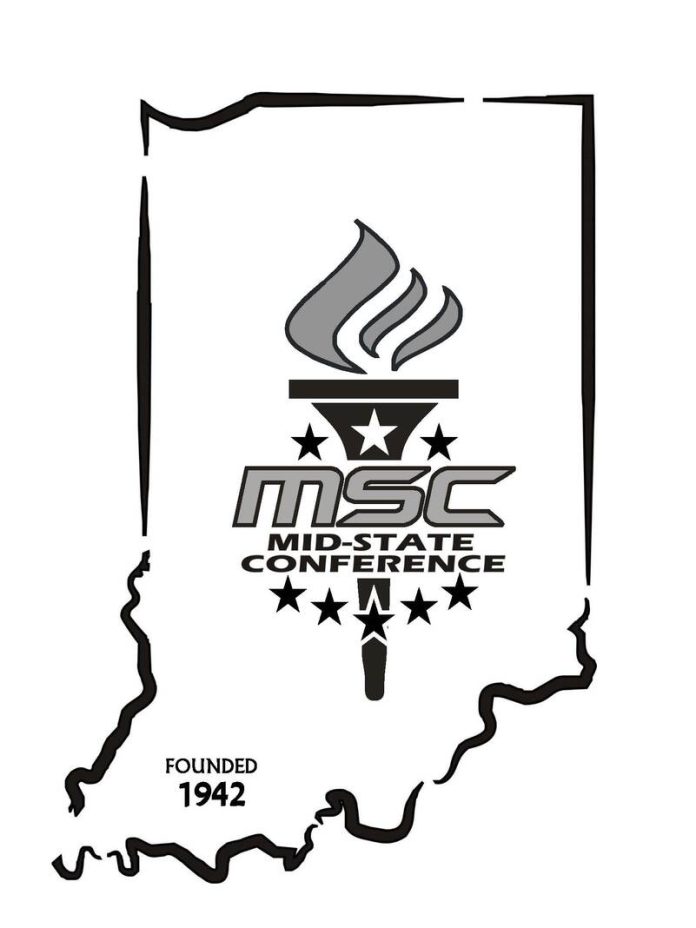Editor’s note: This story is the second in a two-part series covering the waves of conference realignment rippling across central Indiana high school sports. More than half of Johnson County’s high schools have left one conference for another (or become independent) within the last two years, including three in just the past few months.
Today, we explore the potential future options for the Mid-State Conference, which is looking to reshape itself after Greenwood’s announced departure.
With any big life change — starting college, moving to a new city, getting over a breakup — comes an opportunity to reinvent yourself.
The Mid-State Conference is officially in the post-breakup stage after Tuesday’s formal announcement that Greenwood will be joining the Hoosier Legends conference in the summer of 2026, but the league — arguably one of the three most powerful across the board in the entire state — isn’t crying into a pint of Ben & Jerry’s and playing Taylor Swift songs.
But with the Woodmen headed for the exit, the seven remaining Mid-State schools (Franklin, Whiteland, Decatur Central, Martinsville, Mooresville, Perry Meridian and Plainfield) do have some decisions to make regarding the future direction of the league. Several schools to the south, west and east of the I-465 loop have expressed interest in joining at one time or another, and numerous scenarios have already been discussed in conversations between athletic directors.
The first question is a basic but complicated one — how many? — with no definitive answer just yet.
“We have to decide how many schools we want, and then we have to go out and find schools that will appease all seven existing members, which is going to be a challenge,” Whiteland AD David Edens said. “It will just be an interesting process, because the landscape in central Indiana is changing so much that I don’t know if sticking to eight schools is going to be a reality.”
Eight would be by far the neatest solution, of course. It’s the easiest number for running single-elimination conference tournaments as well as championship meets in swimming, track or wrestling. It would also just require finding one new member to replace Greenwood. But as Edens noted, the seismic changes already happening around the middle of the state might necessitate a go-big approach like the ones we’ve seen taken across major college sports in recent years.
Does the Mid-State add, say, Bloomington North, Bloomington South and Southport and go to 10? Do one or both of the Columbus schools enter the equation? Does the eastside trio of Greenfield-Central, Mt. Vernon and New Palestine come into the picture in an effort to appease Martinsville and Mooresville, currently the league’s two smallest schools by a fair amount?
Would any consideration be given to going as big as 14 or even 16 teams, with divisions broken up in some fashion (east-west, north-south or big-small)? How widespread is the league willing to get geographically?
And would the giant in the middle of the map — Center Grove — ever be seriously considered if it applies? (Probably not.)
Whatever it ends up looking like, the Mid-State knows that it it needs to get out in front of the rising wave before it ends up eating sand, because somebody, or likely a few somebodies, will be once the waters recede.
The good news is that the league should have a few viable options, and it can select the school or schools that fit best.
“I think you find the schools that are solid across the board in all sports and they raise the profile of your conference,” Edens said. “The goal here should be to take what is a very desirable conference, obviously, and make it better.”
What better looks like might be in the eye of the beholder. Mid-State Conference bylaws state that prospective members should have a similar enrollment and facilities to current conference schools, be willing to participate in all sponsored sports and be within a reasonable driving distance of all member schools. Those seeking membership must apply in writing to the conference president (that’s Mooresville AD Mike Mossbrucker right now) and be admitted by a two-thirds vote of all member schools — meaning five out of seven votes would currently be needed to clear that bar.
Would there be enough support across the board to get to a 12-member superconference with two divisions (Franklin, Whiteland, Perry, Southport and the Columbus schools in the east and Decatur, Martinsville, Mooresville, Plainfield and the Bloomingtons in the west)? It could set up an eight-game conference schedule in football where teams play everyone within their division and then half of the other, alternating opponents yearly; other sports could see either an 11-game round robin or a 16-team slate where division foes face each other twice.
Franklin athletic director Bill Doty believes that as long as each school considers the greater good of the league instead of looking out for its own individual best interest, arriving at a consensus — whatever it might be — shouldn’t be incredibly difficult.
But that cohesiveness could be tested in the weeks and months to come as the Mid-State embarks on a choose-your-own-adventure that will likely define its long-term future and decide whether a league that has survived, and thrived, as one of the state’s best for more than 80 years can keep rolling for generations to come.
BY THE NUMBERS
A look at the enrollments (and state rank in that category) of current Mid-State Conference schools as well as a handful of potential replacement or expansion candidates:
Current members
Perry Meridian 2359 (24)
Whiteland 2074 (33)
Decatur Central 1883 (42)
Plainfield 1773 (47)
Franklin 1590 (54)
Mooresville 1398 (68)
Martinsville 1315 (75)
Potential additions
Center Grove 2893 (16)
Southport 2368 (23)
Columbus North 2267 (26)
Bloomington South 1681 (52)
Bloomington North 1589 (55)
Columbus East 1518 (58)
Mt. Vernon 1455 (64)
Greenfield-Central 1430 (65)
New Palestine 1209 (83)





